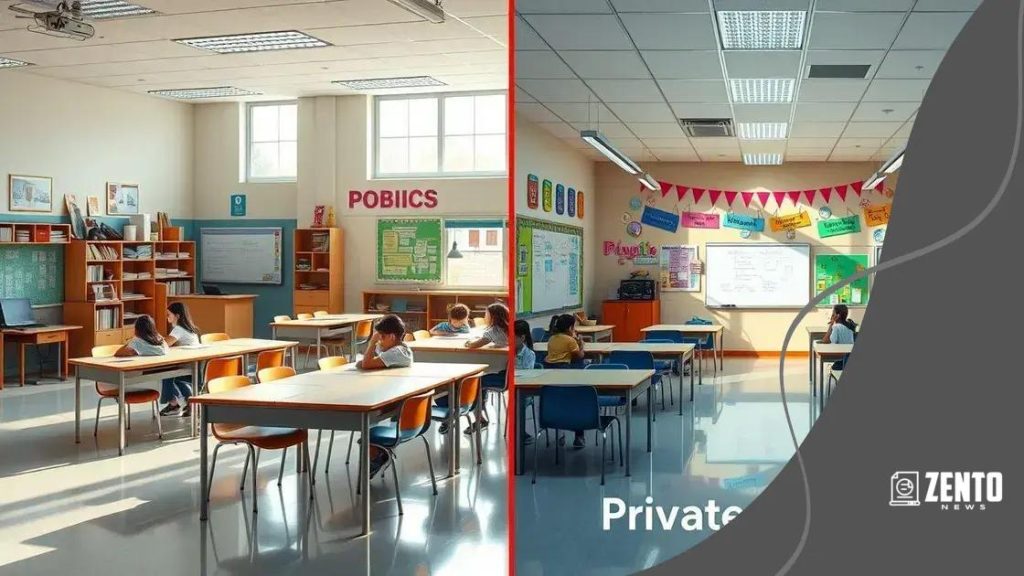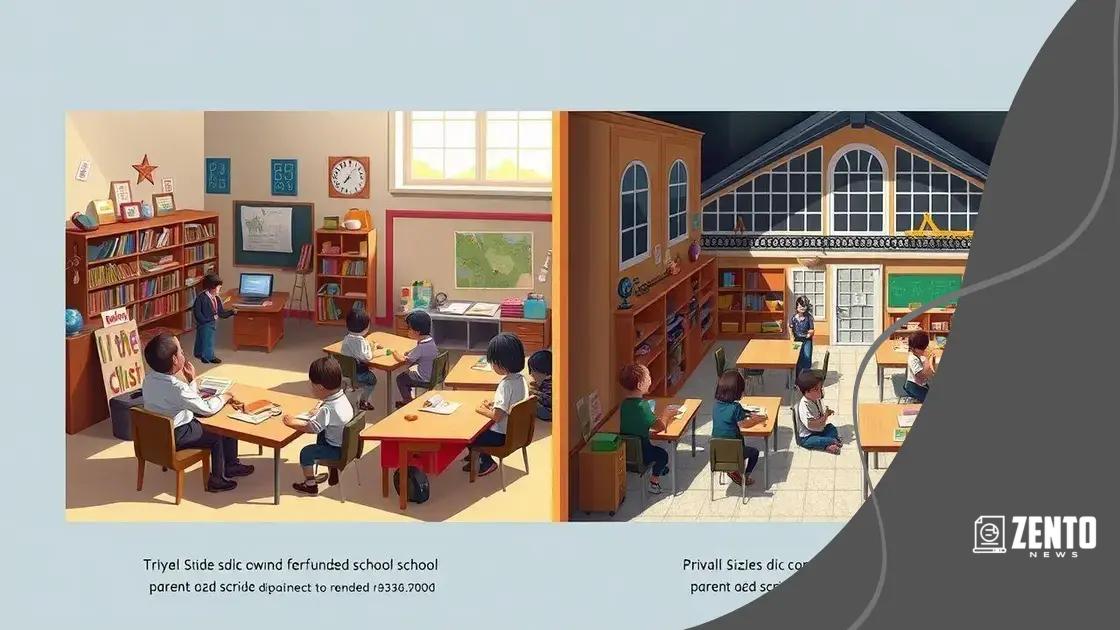Public-private school gap: understanding the differences

Anúncios
The public-private school gap refers to the disparities in resources, funding, and student outcomes between public and private educational institutions, significantly impacting students’ academic experiences.
Public-private school gap refers to the disparities seen in educational experiences and outcomes. Understanding these differences can help us address issues affecting students today. How does this impact you or your community?
Anúncios
What is the public-private school gap?
The public-private school gap is a significant topic in education today. It addresses the differences in quality and resources between public and private institutions. Understanding this gap is crucial for grasping how it affects students and communities.
Public schools are funded by taxpayer money. They offer education to all children, regardless of their backgrounds. Private schools, on the other hand, rely on tuition and private funding. This often leads to varying levels of resources available to students.
Key Differences Between Public and Private Schools
- Funding Sources: Public schools depend on government funding, while private schools rely on tuition and donations.
- Class Sizes: Private schools typically have smaller class sizes, which can lead to more individualized attention for students.
- Curriculum Flexibility: Private schools often have greater flexibility in their curriculum choices compared to public schools, which must adhere to state standards.
- Teacher Qualifications: Public school teachers are generally required to have state certification, while private school requirements may vary.
These differences can lead to a variety of outcomes for students. Research shows that students in private schools often have access to more advanced courses and extracurricular activities. However, public schools strive to meet diverse needs, accepting all students and providing various programs to help them succeed.
Anúncios
The public-private school gap also raises questions about equity in education. Communities should consider how these disparities impact students from different socio-economic backgrounds. It is important to explore how all students can receive a quality education, no matter where they attend school.
Impact on student performance
The impact on student performance due to the public-private school gap is a critical area of concern. Research suggests that students in private schools often achieve higher test scores and have better overall academic success. Understanding why this occurs can help address educational inequalities and improve outcomes for all students.
Public schools cater to a diverse population and often serve students with varying needs. They provide essential support services, like counseling and special education programs, to ensure that every student has the opportunity to succeed. While public schools work hard to meet these diverse needs, challenges like larger class sizes can make personalized attention difficult.
Factors Affecting Student Performance
- Resource Availability: Private schools may have more funding for advanced technology, extracurricular activities, and classroom materials.
- Class Size: Smaller class sizes in private schools often allow for more one-on-one instruction, benefiting student learning.
- Parental Involvement: Parents who choose private schools are typically more involved in their child’s education, which can positively influence academic performance.
- Curriculum Differences: Private schools often offer specialized programs and advanced placement courses that may not be available in public schools.
Despite these challenges, it’s important to recognize that many public schools are making strides to improve student performance. Schools are implementing new programs and teaching methods to help boost academic achievement. Research indicates that student performance can also be impacted by factors outside of school, such as home environment and community support.
Ultimately, understanding the impact on student performance within the context of the public-private school gap is essential. It highlights the need for ongoing discussions about educational equity and how to provide every student with the tools they need to succeed.
Factors contributing to the gap

There are many factors contributing to the gap between public and private schools. Understanding these elements is essential for identifying ways to improve education for all students. Each factor plays a role in shaping the experiences of students in different types of schools.
One significant aspect is funding. Public schools receive money from local, state, and federal governments, which can vary widely based on location. In contrast, private schools rely on tuition fees and donations. This difference in funding levels affects the resources available, such as books, technology, and facilities.
Key Factors Influencing the Public-Private School Gap
- Funding Disparities: Public schools often struggle with budget constraints, whereas private schools can offer premium services due to higher funding.
- School Policies: Different admission criteria in private schools lead to student bodies that may have fewer special needs or challenges.
- Parental Involvement: Parents of private school students are usually more involved, often leading to better engagement in their child’s education.
- Class Sizes: Private schools typically maintain smaller class sizes, allowing for more personalized instruction for each student.
Another important factor is location. Schools in affluent areas tend to be better funded and offer more resources. This can create a significant advantage for private schools in these areas. Additionally, public schools in low-income neighborhoods often face obstacles such as overcrowded classrooms and limited access to extracurricular activities.
The gap is also influenced by differences in curriculum. Private schools may have more flexibility to adopt innovative teaching methods or specialized programs, which can enhance student engagement and learning outcomes. Recognizing these factors helps to shine a light on the complexities of the education system and the challenges students face.
Case studies of public vs. private schools
Case studies of public vs. private schools provide valuable insights into the differences in educational outcomes and experiences. By analyzing specific examples, we can better understand how variables such as funding, student demographics, and educational approaches impact student success.
One notable case study involves a public school in an urban area with limited funding. This school faces challenges such as overcrowded classrooms and a lack of resources. Despite these difficulties, teachers are committed to providing an engaging education. They work hard to implement innovative teaching strategies and foster a supportive school community.
Comparative Analysis
- Student Performance: Students at this public school often face external challenges that can affect their academic results. However, they show resilience and adaptability.
- Programs Offered: The public school offers various support programs, such as after-school tutoring and mentoring, designed to help students succeed.
- Community Involvement: Strong community support can be seen, as many local organizations partner with the school to enhance resources and programs.
In contrast, a private school in the same city has access to greater financial resources. This allows for smaller class sizes and a wider range of extracurricular activities. In this environment, students typically benefit from personalized instruction and enriched educational experiences.
The private school case study shows that students are often involved in specialized programs, from arts to advanced sciences. The level of parental involvement is also significantly higher, further enhancing student engagement and motivation. Parents actively participate in school activities and fundraise to support their children’s education.
These contrasting case studies highlight the diverse experiences between public and private schools. They demonstrate the importance of understanding the broader context of education and the unique challenges and benefits each type of school presents.
Potential solutions and policy recommendations
Addressing the public-private school gap requires thoughtful solutions and effective policy recommendations. Policymakers and educators must work together to create equitable educational opportunities for all students. By understanding the disparities, we can implement strategies that benefit everyone.
One potential solution is increasing funding for public schools. Ensuring that all schools have access to adequate resources is essential for leveling the playing field. This can involve reallocating funds from higher-income areas to support schools in low-income neighborhoods.
Policy Recommendations for Improvement
- Support for Underfunded Schools: Develop initiatives that target resources to public schools struggling with budget constraints.
- Teacher Training Programs: Invest in professional development for teachers in both public and private schools to enhance teaching quality.
- Community Partnerships: Encourage collaborations between schools and local organizations to provide additional support and resources.
- Flexible Curriculum Options: Allow schools more freedom in choosing educational programs that best meet the needs of their students.
Another key approach is to promote programs that foster collaboration between public and private schools. By sharing best practices and resources, both types of schools can learn from each other. This can create a more cohesive educational system where all students thrive.
Additionally, increasing parental involvement in public schools can help improve student outcomes. Providing resources and training for parents can empower them to engage more effectively in their children’s education, leading to better academic results overall.
By implementing these potential solutions and policy recommendations, we can work toward closing the public-private school gap and ensuring that every student has access to a high-quality education. This collaborative approach will ultimately benefit the entire community.
In conclusion, addressing the public-private school gap is vital for ensuring all students receive quality education. By understanding the factors that contribute to this gap and implementing effective solutions, we can create a more equitable education system. Schools, parents, and communities must work together to enhance resources, promote collaboration, and support policy changes. This approach will help bridge the gap and provide every student with the opportunities they deserve, setting them up for future success.
FAQ – Frequently Asked Questions about the Public-Private School Gap
What factors contribute to the public-private school gap?
Factors include funding disparities, differences in parental involvement, class sizes, and the resources available to each type of school.
How does student performance differ in public and private schools?
Students in private schools often have higher test scores, partly due to smaller class sizes and more resources, while public schools serve a diverse student population.
What solutions can help close the public-private school gap?
Increasing funding for public schools, enhancing community support, and promoting parental involvement can significantly help bridge the gap.
Why is collaboration between schools important?
Collaboration allows public and private schools to share resources and best practices, leading to improved educational outcomes for all students.





